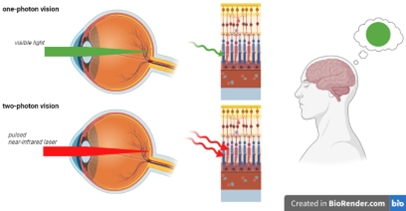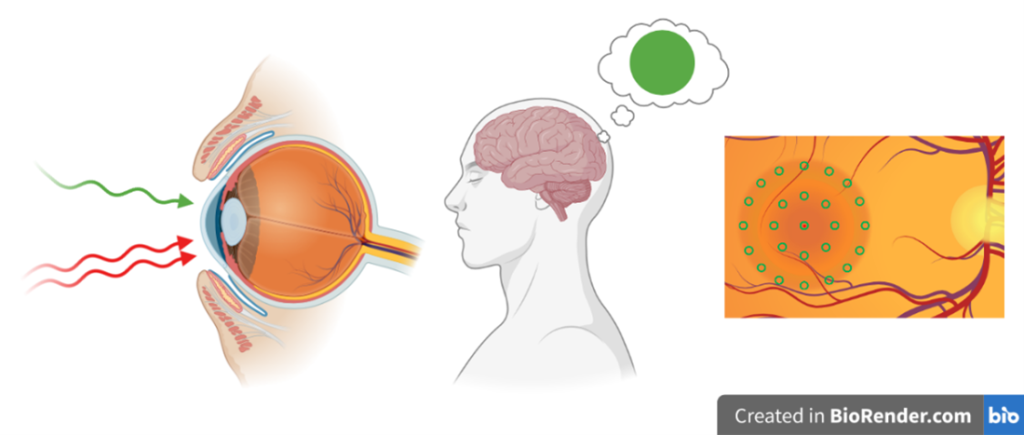Vision allows for receiving stimuli from the surrounding world through electromagnetic waves from 400 to 780 nm, called visible light. It begins when a photon of such light is absorbed by the visual pigment of the photoreceptor in the light-sensitive part of the eye – the retina. Absorption of a photon initiates a series of biochemical reactions, as a result of which light is converted into an electrical signal, which is later processed in the brain.
Two-photon vision relies on the two-photon absorption occurring in visual pigments upon irradiation by ultrashort near-infrared lasers. The visual system reacts as if one photon of light is absorbed in the photoreceptors, while two photons of infrared radiation of twice the lower energy are absorbed. The observer perceives the stimulus as if it had a color corresponding to about half the excitation wavelength of the infrared laser beam.

Two-photon vision has several interesting properties different from “normal” one-photon vision. First, it occurs for a different spectral range: from about 800 nm to 1300 nm – for these wavelengths; the color impression changes from blue, green, yellow, and finally, red. Second, the brightness of a two-photon stimulus varies quadratically with the power of optical radiation, so light scattered in the eye will not be perceived. Brightness also depends on the beam’s focus on the observer’s retina. Observed stimuli have better contrast and sharpness than “normal” one-photon vision.
At the International Centre for Translational Eye Research, we study the phenomenon of two-photon vision – we discover its properties and describe them for the first time. We are also looking for applications of this phenomenon in medical diagnostics (e.g., two-photon microperimetry) and visualization systems (virtual retinal displays).
Two-photon microperimetry
The conventional approach to visual field testing is based on displaying visible stimuli at various locations on the patient’s retina and recording their response. Unfortunately, the accuracy and reproducibility of classical visual field testing methods are limited. Moreover, we cannot use it in cases of patients with opacities of the eye media (e.g., cataracts).
Two-photon microperimetry, a new diagnostic technique that uses pulsed infrared beams to stimulate the retina of the subject, may be the answer to these challenges. Such stimuli are perceived through the process of two-photon vision. The use of two-photon perception for visual field testing has several advantages. Unlike visible light, infrared radiation is less scattered on the opacities of the eye’s optical medium. In addition, two-photon vision is a nonlinear optical process, resulting in smaller spread of visual threshold values compared to classical microperimetry. This translates into better reproducibility of the visual field examination.
At the International Centre for Translational Eye Research, we are developing the technique of two-photon microperimetry, including studying the effects of different parameters of pulsed laser sources – wavelength, pulse length and repetition rate – on the efficiency of retinal stimulation.

Authors: Katarzyna Komar, PhD and Marcin Marzejon, PhD
Team:
Publications:
- G. Palczewska, F. Vinberg, P. Stremplewski, M. P. Bircher, D. Salom, K. Komar, J. Zhang, M. Cascella, M. Wojtkowski, V. J. Kefalov, and K. Palczewski, “Human infrared vision is triggered by two-photon chromophore isomerization,” Proc. Natl. Acad. Sci. U. S. A. 111(50), E5445–E5454 (2014).
- D. Ruminski, G. Palczewska, M. Nowakowski, V. Kefalov, K. Komar, K. Palczewski, and M. Wojtkowski, “Two-photon microperimetry: sensitivity of human photoreceptors to infrared light,” Biomed. Opt. Express 10(9), 4551–4567 (2019).
- G. Łabuz, A. Rayamajhi, J. Usinger, K. Komar, P. Merz, R. Khoramnia, G. Palczewska, K. Palczewski, and G. U. Auffarth, “Clinical application of infrared-light microperimetry in the assessment of scotopic-eye sensitivity,” Transl. Vis. Sci. Technol. 9(8), 1–9 (2020).
- M. J. Marzejon, Ł. Kornaszewski, J. Bogusławski, P. Ciąćka, M. Martynow, G. Palczewska, S. Maćkowski, K. Palczewski, M. Wojtkowski, and K. Komar, “Two-photon microperimetry with picosecond pulses,” Biomed. Opt. Express 12(1), 462–479 (2021).
- M. Marzejon, Ł. Kornaszewski, M. Wojtkowski, and K. Komar, “Effects of laser pulse duration in two-photon vision threshold measurements,” in Ophthalmic Technologies XXXI, D. X. Hammer, K. M. Joos, and D. V Palanker, eds. (SPIE, 2021), 11623, pp. 74–79
- G. Łabuz, A. Rayamajhi, R. Khoramnia, G. Palczewska, K. Palczewski, A. Holschbach, and G. U. Auffarth, “The loss of infrared-light sensitivity of photoreceptor cells measured with two-photon excitation as an indicator of diabetic retinopathy: A pilot study,” Retina 41(6), 1302–1308 (2021).
- D. Stachowiak, M. Marzejon, J. Bogusławski, Z. Łaszczych, K. Komar, M. Wojtkowski, and G. Soboń, “Femtosecond Er-doped fiber laser source tunable from 872 to 1075 nm for two-photon vision studies in humans,” Biomed. Opt. Express 13(4), 1899–1911 (2022).
- A. Zielińska, P. Ciąćka, M. Szkulmowski, and K. Komar, “Pupillary Light Reflex Induced by Two-Photon Vision,” Investig. Opthalmology Vis. Sci. 62(15), 23 (2021).
- M. J. Marzejon, “Two-photon perimetry utilizing picosecond lasers,” Gdańsk University of Technology (2022).
- O. Kaczkoś, A. Zielińska, M. J. Marzejon, J. Solarz-Niesłuchowski, J. Pniewski, K. Komar, “Methods of determining the contrast sensitivity function for two-photon vision,” Proc. SPIE 12502, 1250215 (2022).
- G. Łabuz, A. Rayamajhi, K. Komar, R. Khoramnia, and G. U. Auffarth, “Infrared- and white-light retinal sensitivity in glaucomatous neuropathy,” Sci. Rep. 12(1), 1961 (2022).
- M. J. Marzejon, PhD thesis “Two-photon perimetry utilizing picosecond lasers”, Gdańsk University of Technology (2022).
- D. Stachowiak, M. Marzejon, J. Bogusławski, Z. Łaszczych, K. Komar, M. Wojtkowski, and G. Soboń, “Femtosecond Er-doped fiber laser source tunable from 872 to 1075 nm for two-photon vision studies in humans,” Biomed. Opt. Express 13(4), 1899–1911 (2022).
- M. J. Marzejon, Ł. Kornaszewski, M. Wojtkowski, and K. Komar, “Laser pulse train parameters determine the brightness of a two-photon stimulus”, Biomed. Opt. Express 14(4), 2857-2872 (2023).

